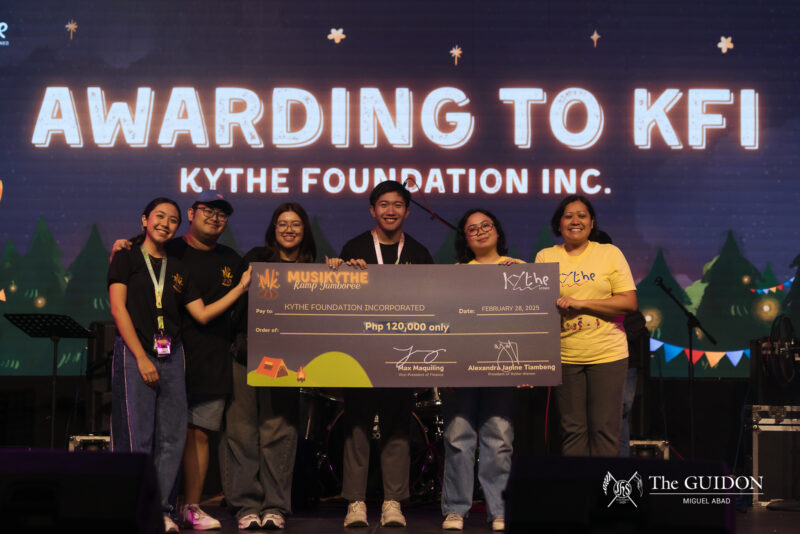A POLICY-MAKING body that will address intellectual property rights (IPR) violations within the Loyola Schools (LS) has been formed by the Sanggunian and the Council of Organizations of the Ateneo (COA).
The committee includes COA because student organizations were involved in the IPR violations brought to attention of the student government.
School of Humanities (SOH) Chair RJ Dimla said that the committee was created with COA as the latter fully supports the Sanggunian’s stand on the IPR violations issue.
The formation of the policy-making body is one of the student government’s first courses of action following the Sanggunian’s release of a resolution condemning IPR violations within the LS last June 14.
The committee was created during an emergency meeting called by Sanggunian President Dan Remo last July 1.
As of press time however, the committee has not been given an official title.
Rise of IPR violation cases
Dimla said that the sudden rise in IPR violations being reported to SOH Sanggunian was what urged them to author the said resolution for the Sanggunian Central Board’s (CB) approval.
“The cases rose significantly. In my freshman year, there were only one to two cases. This year, during summer semester alone, I received six,” he added.
Last July 4, the committee convened for the first time to discuss further courses of action regarding the IPR issue.
“Both institutions (Sanggunian and COA) are working with [the] Office of Student Activities (OSA) on how we can establish the resolution more effectively than what happened in the past few weeks,” COA President Micha Aldea said in a text message.
The Sanggunian consulted with several professors and representatives from different student organizations with regard to the IPR protection policies that the committee is planning to create.
However, Aldea and Dimla have refused to divulge specific details of the said meeting as the committee has yet to finalize their plans.
According to the Sanggunian’s resolution, cases of IPR violations were identified either as “alterations to the Atenean student/artist’s creative output without the creator’s consent, [or] usage of similar creative outputs without the creator’s consent and/or approval.”
Moreover, the resolution stated that these cases are violations of Republic Act No. 8293, otherwise known as the “1997 Intellectual Property Code of the Philippines.”
Crafting policies
According to Dimla, the long-term objective of the committee is to craft policies by the second semester that will enable governing bodies such as the Sanggunian to reprimand liable parties.
He added that they will still have to consult with the Office of the Associate Dean for Student Affairs (ADSA) with regard to the proper disciplinary measures to be taken.
However, because there are still no definite policies addressing IPR violations stipulated in the student handbook, Dimla said that the best the Sanggunian can do for now is receive reports of these cases and ultimately demand an apology from violators.
“For now, at least, we will be fighting for the artists’ rights,” Dimla said.
Meanwhile, Junior SOH CB Representative Juno Reyes said that in line with crafting policies, the committee’s goal is to have a separate manual similar to the Ateneo Intellectual Code, which will handle plagiarism cases not of the academic type.
Plagiarism, described as an act of academic dishonesty under the “Code of Academic Integrity of the Loyola Schools,” currently covers written output for academic work, not restricting this to print sources.
It is defined as “the objective act of falsely attributing to one’s self what is not one’s work, whether intentional or out of neglect.”
Defining terms
Reyes said that, before the committee can submit a list of policies to OSA for review, it needs to define certain terms first.
For one, the committee is setting parameters for IPR violations that are considered copyright infringement by differentiating “pegging” from “outright copying.”
SOH Chair Dimla said, “For pegging, you only used [a work] as an inspiration. You will only get certain elements but you would use it in a completely different context.”
“Outright copying is similar context, similar identities, very similar look and similar characteristics,” he added.
When asked how copyright infringement can be avoided, both Dimla and Reyes said that proper citation of works used or consulted is imperative.
Dimla also suggested that, to avoid outright copying, artists should consult different works to draw inspiration from and then create their own, completely different idea.
Early allegations
Last June 27, Dimla posted one of the promotional materials of the Melbourne Dance Company on his Twitter account to further emphasize the difference between pegging and outright copying.
While Dimla did not name any student organizations in his post, the said poster of the Australia-based ballet company had similarities with the promotional materials used by The Company of Ateneo Dancers (CADS) during Recruitment Week 2013.
The tweet, however, was deleted from Dimla’s account hours after it was posted.
In an interview with The GUIDON, CADS Marketing Officer Gisella Velasco clarified that they used the promotional material of the Melbourne Dance Company strictly as a peg and did not directly copy it, contrary to what Dimla’s tweet implied.
“We tried to make sure it was different. I mean, that wasn’t our only peg that, at least. We had other sources of inspiration,” Velasco said.
“We get from a lot of sources and we try to put it together to make it our own. We did try to be original as much as possible, especially with how we ask our models to pose and how we place some of the lettering,” she added.
Dimla responded by saying that the CADS case was brought to his attention by a group of students in a Principles of Design class who noticed similarities in artistic structure between the peg and the actual promotion.
He also said that it was not his or the Sanggunian’s intentions to pinpoint any organizations.
The issue has since been resolved among the concerned parties. According to Velasco, Dimla apologized to the groups involved during the aforementioned meeting last July 4.
Cases of alteration
Another type of IPR violation that the Sanggunian put forward during the meeting was the alteration of an artist’s work without the creator’s consent.
One such case presented to Dimla involved junior interdisciplinary studies major Ryan Racca, who was hired as a photographer for a student-organized event that he refused to name.
Racca related that the colors of the photo he submitted for the event’s promotional materials were altered without his knowledge or consent.
“One week after [I submitted], the tarpaulins were released and I got annoyed that the photo’s colors were changed,” said Racca in a mix of English and Filipino.
“When I do photography, I’m really sensitive with the colors and I take my time to make the colors the way I want it,” he said.
“I mean, it’s a little thing, but it’s something I worked [on] for so long,” Racca added.
However, he said that he did not “reproach” the committee of the said event because he felt that he nothing more could be done about it at that point.
Another case involved two junior artists who worked on the tickets for the 2013 School of Social Sciences (SOSS) Welcoming Night, which took place last June 7.
The two refused to be named.
Like Racca, the artists only found out that their work was altered when the actual tickets for the said event were released online.
“The fonts were not the same and the only main thing that was the same was the backdrop. And even the backdrop was sort of pushed upwards, and so were the other designs,” said one of the artists.
Unlike Racca’s case, however, the artists made their sentiments known to SOSS Welcoming Night Promotions Head Kat Nieto.
In a text message sent to The GUIDON, Nieto admitted that she had edited the text on the tickets and that she had already apologized to the hired artists.
She further explained that time constraints inhibited her from contacting the artists again and asking for more revisions.
With reports from Pauline V. Miranda
Editor’s Note: Ryan Racca is a member of The GUIDON’s Photos Staff.







